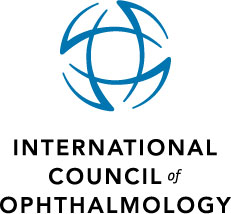| Pseudoexfoliation Material at Surface of Cristalline Lens in Unilateral Secondary Open Angle Glaucoma (slit lamp retroillumination photography) | |
| Patient: 54 years of age, male, BCVA light perception at OS, IOP 12/23 mmHg under Brimonidin and Xalatan. Ocular Medical History: cataract , since 15 years increased IOP at OS. General Medical History: empty Main Complaint: deterioration of vision at OS Purpose: to show pseudoexfoliation material at the surface of the cristalline lens by slit lamp retroillumination photography . Methods: slit lamp retroillumination photography , colour fundus photography, OCT (Heidelberg Engineering). Findings: Slit lamp retroillumination photography of anterior segment: documenting retroilluminated lens opacities by pseudoexfoliation material at the surface of the cristaline lens. Slit lamp photography of anterior segment: showing pseudoexfoliation material at the surface of the cristaline lens. Colour fundus photography of posterior segment: optic nerve head showing a deep excavated cup due to an advanced glaucomatous optic nerve atrophy. OCT: circular scan showing a strong reduction of the retinal nerve fiber thickness. Discussion: Pseudoexfoliation (PEX) represents the most common identifiable cause of open-angle glaucoma and a leading cause of blindness worldwide. PEX syndrome is a genetically determined, generalized disease of the extracellular matrix leading to the progressive deposition of an abnormal fibrillar material in various intraocular and extraocular tissues including the trabecular meshwork. Schlötzer-Schrehardt (1) reported, that the PEX-specific fibrotic matrix process is a stress-induced elastosis. It is characterized by an excessive production and abnormal cross-linking of elastic microfibrils into fibrillar PEX aggregates. She showed, that co-modulating factors triggering this fibrotic process include elevated concentrations of fibrogenic growth factors, such as TGF-β1, reduced activity of proteolytic enzymes, subtle inflammatory processes and various external stress factors. Genetic studies identified a highly significant association between several polymorphisms in the LOXL1 (lysyl oxidase-like 1) gene with both PEX syndrome and PEX glaucoma. Literature: (1) Schlötzer-Schrehardt U. New pathogenetic insights into pseudoexfoliation syndrome/glaucoma. Therapeutically relevant? Ophthalmologe. 2012 Oct;109(10):944-51. | |
| Roessler, Kathrin, Dr.med., Augenklinik, Friedrich-Alexander-Universität, Deutschland, Erlangen, Deutschland; Michelson, Georg, Prof. Dr. med., Interdisziplinäres Zentrum für augenheilkundliche Präventivmedizin und Imaging, Augenklinik, Friedrich-Alexander-Universität, Deutschland, Erlangen, Deutschland | |
| H40.1 | |
| Lens -> Cataract and Associated Systemic Diseases (see: Systemic Diseases) -> Pseudoexfoliation Material at Surface of Cristalline Lens in Unilateral Secondary Open Angle Glaucoma (Retroillumination Photography, Colour Photography ) | |
| PEX | |
| 9664 |
|
|||||||||||||||
Pseudoexfoliation Material at Surface of Cristalline Lens in Unilateral Secondary Open Angle Glaucoma (slit lamp retroillumination photography)-------------------------- -------------------------- -------------------------- -------------------------- -------------------------- -------------------------- -------------------------- -------------------------- -------------------------- -------------------------- -------------------------- -------------------------- |
|
||||||||||||||




